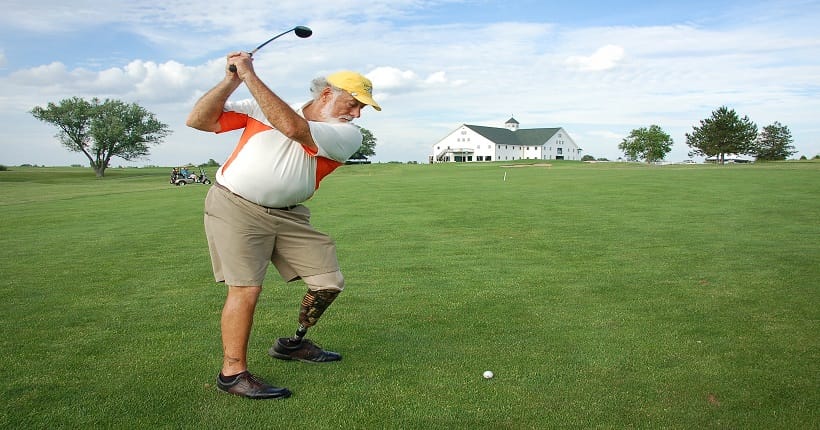How Many Miles Is 18 Holes Of Golf?
18 holes of golf typically cover a distance of approximately 5 to 6 miles, depending on the course layout. Golf courses vary in terms of size and design, but on average, a golfer can expect to walk around 5 miles during a full round of 18 holes.
This distance can be higher or lower depending on factors such as the course’s terrain, the positioning of each hole, and the golfer’s navigation skills. Walking 18 holes not only provides exercise and fresh air but also allows golfers to fully appreciate the scenic beauty of the course.

Credit: www.golfdigest.com
The Physicality Of Golf
Discovering the physicality of golf is key to understanding how many miles you might cover during 18 holes. Embark on this thrilling journey and witness the distance your swings can take you. Get ready to traverse the course and witness the manifestation of your skill and determination.
Golf enthusiasts often contemplate how many miles they cover during a round of golf. Whether you’re a curious beginner or a seasoned golfer, understanding the physicality of golf can provide some insights into the distance covered on the course. In this blog post, we will explore the various factors that affect the distance covered in a game of golf, while highlighting golf as a low-intensity intermittent sport.
Golf As A Low-Intensity Intermittent Sport
- Golf is recognized as a low-intensity intermittent sport due to the combination of walking, swinging, and occasional bursts of higher intensity movements.
- While it may not require the same level of cardiovascular exertion as more fast-paced sports, golf still offers a range of physical benefits.
- The intermittent nature of the game allows players to maintain a moderate level of activity throughout the round.
Exploring The Physical Activity Involved In Golf
- Walking: One of the primary physical aspects of golf is walking from one hole to another. Most courses cover a distance of 5,000 to 7,000 yards (2.8 to 4 miles) in total, with each hole averaging between 100 to 500 yards. Walking this distance can significantly contribute to the overall physical activity.
- Swinging: The act of swinging a golf club requires a combination of strength, flexibility, and coordination. A typical 18-hole round involves around 70 to 100 swings, engaging multiple muscle groups.
- Carrying or Pulling Golf Bag: If you choose to carry your own clubs or use a pull cart, the additional weight can add to the physical exertion during the round.
- Terrain Variations: The distance covered in golf can be influenced by the layout and topography of the course. Playing on undulating courses or traversing hilly terrain can increase the overall distance covered.
Factors Affecting Distance Covered In Golf
- Golf Course Design: The length and layout of the course can significantly impact the distance covered. Longer courses with wide spacing between holes may require more walking, while shorter ones may involve less distance traveled.
- Playing Style: Aggressive players who hit the ball farther may need to cover more ground to reach their target. On the other hand, conservative players may have shorter distances to walk.
- Pace of Play: The speed at which a round is played can also affect the distance covered. Faster play may result in less overall walking distance.
- Weather Conditions: Factors such as wind, temperature, and humidity can influence player fatigue and energy expenditure, potentially impacting the distance covered during a round.
Understanding the physicality of golf can shed light on the distance covered during a round. Whether you’re enjoying a leisurely stroll on a picturesque course or engaging in a competitive game, golf provides a unique blend of physical activity and mental focus.
So grab your clubs, hit the green, and enjoy the sport that offers both exercise and relaxation.
Calculating The Distance Of 18 Holes
18 holes of golf typically cover a distance of about 4 to 5 miles, allowing players to walk or ride through the course while enjoying the game. The length may vary depending on the golf course and its layout.
Golf is a sport that combines skill, strategy, and precision. While many golfers focus on improving their swing and scoring, it’s also interesting to delve into the logistics of the game. One commonly asked question is, “How many miles is 18 holes of golf?
” In this post, we will explore the factors that contribute to the distance of 18 holes, including the length of each hole, the layout and design of the golf course, and variations in distance among different courses.
Determining The Length Of Each Hole:
Every golf course is unique, with its own set of challenges and characteristics. The length of each hole can vary significantly, affecting the overall distance of 18 holes. Here are a few factors that determine the length of each hole:
- Tee boxes: Different tee boxes offer varying starting points for golfers, providing options for players of different skill levels.
- Fairways: The width and distance of the fairways influence the overall length of each hole.
- Roughs: The rough areas surrounding the fairways are usually longer and harder to navigate, increasing the challenge and distance of the holes.
- Hazards: Bunkers, water bodies, and out-of-bounds areas strategically placed on the golf course can make a hole longer and more challenging.
Considering The Layout And Design Of The Golf Course:
The layout and design of a golf course play a crucial role in determining the distance of 18 holes. Here are some aspects to consider:
- Par: Each hole on a golf course is assigned a par value, indicating the number of strokes expected for an average golfer to complete the hole. Par 3 holes are generally shorter, while par 4 and par 5 holes are longer.
- Routing: The way the holes are routed on a course impacts the total distance. Courses may be designed to create variations in length throughout the 18 holes, providing a mix of short and long holes.
- Elevation changes: A course with significant elevation changes can affect the distance of each hole. Uphill holes tend to play longer, while downhill holes may play shorter.
Examining Variations In Distance Among Different Golf Courses:
The distance of 18 holes can differ not only between courses but also within the same course. Here are a few reasons for these variations:
- Course rating and slope: Each golf course is assigned a course rating and slope rating, which take into account the difficulty level and the expected playing length of the course. These ratings can vary from course to course, resulting in differences in distance.
- Course setup: Golf courses can be set up differently for different events or seasons. Depending on the selected tees and pin placements, the overall distance of the course can change.
- Design philosophy: Golf course architects may have varying design philosophies, leading to differences in length among courses they have designed.
By understanding the factors that contribute to the distance of 18 holes, golfers can gain a deeper appreciation for the game and better strategize their approach on the course. So, whether you’re walking or riding a golf cart, get ready to cover some miles for a round of golf.
Analyzing Factors Affecting Distance
Analyzing factors affecting distance in golf is crucial when determining the total mileage for 18 holes. Various elements, including course layout, tee selection, and player skill level, can influence the final distance covered. Understanding these factors is essential for players and enthusiasts alike.
Golf is a sport that combines skill, technique, and strategy. Each round of golf is made up of 18 holes, which begs the question: how many miles is 18 holes of golf? The distance covered on a golf course can vary depending on various factors.
We will delve into the impact of golf swing mechanics, the influence of playing style and technique, the effects of golf course conditions, the importance of terrain and course elevation, and the impact of player skill level on the distance covered.
Impact Of Golf Swing Mechanics:
- Golf swing mechanics play a crucial role in determining the distance covered during a round of golf.
- Proper swing mechanics, including a controlled backswing, release of the clubhead at the right moment, and follow-through, can maximize the distance achieved.
- The efficiency and speed of the swing greatly affect the launch angle and ball speed, ultimately impacting the distance covered.
Influence Of Playing Style And Technique:
- Different golfers have unique playing styles and techniques that can affect the distance covered.
- Factors such as the choice of clubs, shot selection, and swing speed can greatly influence the distance achieved.
- Golfers who possess a more aggressive playing style and employ powerful techniques are likely to cover more distance than those with a more conservative approach.
Effects Of Golf Course Conditions On Distance:
- The conditions of the golf course can significantly impact the distance covered.
- A dry course with firm fairways and fast greens can result in longer drives and overall increased distance.
- Conversely, a wet course with soft fairways and slower greens may limit the distance achieved, as the ball tends to stop more quickly upon landing.
Importance Of Terrain And Course Elevation:
- The terrain and elevation of a golf course can affect the distance covered by each shot.
- Uphill shots require more effort and may cover a shorter distance, while downhill shots can result in longer distances.
- Courses with varying elevation levels pose an additional challenge, as the distance covered can vary greatly depending on the hole’s location.
Impact Of Player Skill Level On Distance Covered:
- The skill level of the golfer plays a significant role in the distance covered during a round of golf.
- Experienced golfers who possess better control over their swings, shot accuracy, and club selection are likely to cover more distance compared to beginners.
- However, it is important to note that distance alone does not guarantee success in golf, as accuracy and strategy also play vital roles.
The number of miles covered during 18 holes of golf can vary based on multiple factors. From golf swing mechanics and playing style to course conditions and player skill level, each aspect contributes to the distance achieved. By understanding and optimizing these factors, golfers can strive to cover more ground on the golf course.
Happy golfing!
Utilizing Technology To Measure Golf Distances
Golf distances can be accurately measured using technology, providing valuable insights for players. When it comes to the distance of 18 holes of golf, it varies depending on the course layout and design. Utilizing modern tools can help determine the number of miles covered during a game.
Golf is a game of precision, and measuring distances accurately is crucial to achieving success on the course. Thankfully, advancements in technology have made it easier than ever to determine the distance between various points on a golf course. GPS and rangefinder devices, along with golf apps, have become indispensable tools for golfers.
In this section, we will explore the importance of GPS and rangefinder devices, as well as analyze their accuracy. Additionally, we will share some popular golf apps that can help you track distances effectively.
Importance Of Gps And Rangefinder Devices:
GPS devices:
- Provide precise information about the distance to key areas on the course, such as hazards, fairways, and greens.
- Help golfers make informed decisions by displaying accurate yardages, allowing them to choose the appropriate club for each shot.
- Improve course management, enabling players to strategize and navigate the course more efficiently.
Rangefinder devices:
- Utilize laser technology to measure distances accurately, providing golfers with precise yardages to specific targets or objects.
- Aid in target acquisition by allowing players to pinpoint distances to flags, bunkers, trees, or any other objects that may affect their shots.
- Enable golfers to calculate elevation changes, which can significantly impact club selection and shot strategy.
Analyzing The Accuracy Of Gps And Rangefinder Devices:
GPS devices:
- GPS technology has come a long way in recent years, offering improved accuracy on golf courses.
- However, occasional variances in measurements may occur due to factors like satellite signal strength or the precision of course mapping data.
- It’s advisable to update the device regularly to ensure accurate yardages as course changes and improvements are made.
Rangefinder devices:
- Rangefinders provide exceptional accuracy, with most devices boasting a margin of error within one yard.
- However, it’s essential to understand that rangefinders require line-of-sight to the target to provide precise measurements.
- Factors such as fog, heavy rain, or obstructed views may affect the device’s accuracy.
Popular Golf Apps For Distance Tracking:
Golfshot:
- Offers comprehensive distance measurements, including precise yardages to hazards, greens, and landing zones.
- Provides aerial views of each hole, allowing golfers to visualize their shots and plan strategy accordingly.
- Offers additional features such as GPS positioning, digital scorecards, and stats tracking.
Hole19:
- Provides accurate GPS yardages to key points on the course, including hazards and greens.
- Allows golfers to track their rounds, record shot distances, and store their performance statistics.
- Offers a user-friendly interface with intuitive visuals and displays.
SwingU:
- Offers accurate GPS measurements to determine distances to hazards, targets, and greens.
- Provides shot tracking capabilities, allowing golfers to analyze and improve their performance over time.
- Features a scorecard functionality and an extensive database of courses worldwide.
Utilizing technology to measure golf distances has revolutionized the way golfers approach the game. GPS and rangefinder devices, along with golf apps, allow players to make more informed decisions, strategize effectively, and ultimately improve their performance on the course. Whether using a GPS device, a rangefinder, or a golf app, these tools provide golfers with the accurate measurements they need to navigate the golf course with precision.
Improving Physical Fitness For Greater Mileage
Physical fitness is key to achieving greater mileage in golf. By improving your endurance, strength, and flexibility, you can tackle the 18 holes with ease and enhance your overall performance on the course.
Golf is not just a leisurely pastime but also a physical activity that requires both stamina and strength. By incorporating specific exercises into your routine, you can improve your physical fitness and increase your mileage on the course. Here are some key areas to focus on:
Incorporating Cardiovascular Exercises:
- Engaging in regular cardiovascular exercises can significantly improve your endurance and stamina on the golf course.
- Consider activities like jogging, brisk walking, cycling, or swimming to get your heart pumping and increase your overall fitness level.
- Aim for at least 30 minutes of cardiovascular exercise, three to four times a week, to reap the benefits on the golf course.
Strength Training Specifically For Golf:
- Developing strength in specific muscle groups is crucial for generating more power and distance in your shots.
- Focus on exercises that target your core, upper body, and lower body strength, such as squats, lunges, planks, and medicine ball twists.
- Incorporating resistance training with weights or resistance bands can further enhance your strength and control during the swing.
Flexibility And Mobility Exercises For Improved Distance:
- Flexibility and mobility are essential for achieving a full range of motion during your golf swing.
- Incorporate stretching exercises for your upper and lower body, with special attention to your arms, shoulders, back, hips, and legs.
- Implementing yoga or Pilates routines can improve your flexibility and help prevent injuries that may hinder your performance on the course.
Importance Of Proper Nutrition And Hydration:
- Good nutrition and hydration are often overlooked but play a vital role in optimizing your golf performance and overall physical fitness.
- Fuel your body with a balanced diet that includes lean proteins, whole grains, fruits, and vegetables, providing the necessary nutrients for energy and recovery.
- Stay hydrated before, during, and after your rounds of golf to maintain focus, prevent fatigue, and aid in muscle function.
By incorporating these aspects into your fitness regimen, you can enhance your physical capabilities on the golf course. Remember, physical fitness goes hand in hand with skill and technique to achieve optimal performance and maximize the mileage of your shots.
So, lace up your shoes, grab your clubs, and strive for greatness on the fairways!
Frequently Asked Questions Of How Many Miles Is 18 Holes Of Golf?
How Many Miles Are Walked In 18 Holes?
The average walking distance for 18 holes of golf is approximately 4. 5 to 6 miles.
Can You Get Fit Playing Golf?
Yes, playing golf can help you get fit by improving your cardiovascular health and engaging your muscles.
How Many Yards Is An 18 Hole?
An 18-hole course typically measures around 6,000 to 7,000 yards in total length.
How Many Miles Is 18 Holes At Augusta?
The 18-hole course at Augusta covers a distance of approximately 7 miles.
How Many Miles Does An Average Golfer Walk During 18 Holes Of Golf?
On average, an 18-hole round of golf covers approximately 4-6 miles, depending on the course layout.
How Long Does It Take To Play 18 Holes Of Golf?
The time it takes to play 18 holes of golf varies, but typically it ranges between 3-4 hours for a foursome.
Conclusion
The distance covered while playing 18 holes of golf can vary depending on the course layout. On average, you can expect to walk between 4 to 6 miles during a round of golf. However, this distance can be influenced by factors like the size of the course, the layout of the holes, and how efficiently you move around the course.
It’s important to note that these numbers are estimates and can differ from player to player. Remember, golf is not just about the physical activity and distance covered, but also about the mental strategy and skill required to navigate each hole.
Whether you’re an avid golfer or a beginner, understanding the distance you’ll be covering can help you plan for the game and ensure you have a comfortable and enjoyable experience on the course. So, next time you hit the links, keep in mind the potential mileage you’ll be walking and embrace the opportunity to enjoy nature, challenge yourself, and improve your golf game.
Happy swinging!







